八年级英语下学期Unit教案
人教版八年级英语下册大单元教学设计优秀案例
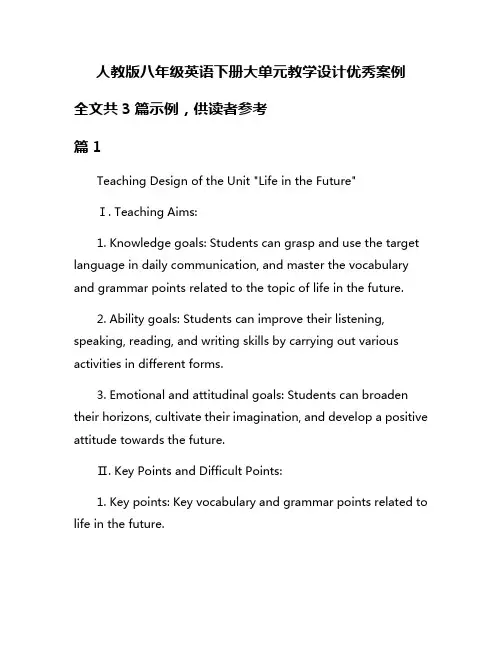
人教版八年级英语下册大单元教学设计优秀案例全文共3篇示例,供读者参考篇1Teaching Design of the Unit "Life in the Future"Ⅰ. Teaching Aims:1. Knowledge goals: Students can grasp and use the target language in daily communication, and master the vocabulary and grammar points related to the topic of life in the future.2. Ability goals: Students can improve their listening, speaking, reading, and writing skills by carrying out various activities in different forms.3. Emotional and attitudinal goals: Students can broaden their horizons, cultivate their imagination, and develop a positive attitude towards the future.Ⅱ. Key Points and Difficult Points:1. Key points: Key vocabulary and grammar points related to life in the future.2. Difficult points: The use of verb tenses to talk about future events, as well as the application of vocabulary and grammar points in practical communication.Ⅲ. Teaching Content:1. New words and phrases related to the topic of life in the future.2. Grammar points: Future tense, comparison of adjectives, modal verbs (could, might, may), etc.3. Reading and listening materials about life in the future.Ⅳ. Teaching Methods:1. Task-based learning approach: Organize various tasks and activities to stimulate students' interest and motivation in learning English.2. Communicative approach: Encourage students to participate in pair work, group work, and class discussions to practice their English speaking skills.3. Multimedia teaching: Use multimedia resources such as videos, pictures, and online resources to create a vivid and engaging learning environment.Ⅴ. Teac hing Procedures:1. Lead-in: Show students a video or pictures related to life in the future to arouse their interest and activate their prior knowledge.2. Presentation: Introduce new vocabulary and grammar points through real-life examples and explain their usage.3. Practice: Conduct various activities such as role-plays, conversations, and games to help students consolidate their knowledge and improve their skills.4. Production: Ask students to write a short paragraph or give a presentation on their vision of life in the future using the target language.5. Evaluation: Assess students' performance through quizzes, tests, and peer evaluations to provide feedback for further improvement.6. Homework: Assign tasks such as writing a diary entry about a day in the future or researching a topic related to life in the future.Ⅵ. Teaching Materials and Resources:1. Textbook: Use the textbook as the main reference for teaching materials and exercises.2. Audio and video materials: Play audio recordings and videos to enhance students' listening and speaking skills.3. Online resources: Use online platforms and websites to access additional materials and practice exercises.4. Visual aids: Use flashcards, charts, and posters to facilitate students' understanding and retention of new information.Ⅶ. Teaching Strategies:1. Differentiated instruction: Provide support and challenge for students of different levels by adjusting tasks and activities accordingly.2. Collaborative learning: Encourage students to work together in pairs or groups to foster teamwork and communication skills.3. Feedback and reflection: Give constructive feedback to students on their performance and encourage self-reflection for continuous improvement.4. Cultural awareness: Integrate cultural elements into the lesson to help students appreciate the diversity of perspectives on life in the future.Ⅷ. Conclusion:Through this comprehensive and innovative teaching design, students will have the opportunity to explore and envision life in the future while improving their English language skills. By engaging in various activities and tasks, students will enhance their communication abilities and develop a positive attitude towards the future. This teaching design aims to create a dynamic and interactive learning environment that motivates students to actively participate in the learning process and achieve academic success.篇2Unit 1: HealthTeaching Goals:1. Students will be able to talk about health habits and give advice.2. Students will be able to discuss different types of illnesses and symptoms.3. Students will be able to understand and use vocabulary related to health and wellness.Key Vocabulary:- illness (n.): a disease or sickness- symptom (n.): a sign that indicates the presence of a disease- fever (n.): a high body temperature- cough (n.): expel air from the lungs with a sudden sharp sound- headache (n.): a continuous pain in the head- sore throat (n.): pain or irritation in the throat- stomachache (n.): pain in the stomach or abdomen- healthy (adj.): in good physical conditionLesson 1: Talking about Health Habits1. Warm-up: Discuss with students what they do to stay healthy. Encourage them to share their health habits with the class.2. Vocabulary: Introduce key vocabulary related to health habits, such as exercise, balanced diet, and enough sleep. Have students practice using the vocabulary in sentences.3. Dialogue Practice: Have students practice a dialogue where they talk about their health habits with a partner.Encourage them to ask follow-up questions to gather more information.4. Role-Play: Divide students into pairs and have themrole-play a scenario where one student gives advice to the other about staying healthy.Lesson 2: Discussing Illnesses and Symptoms1. Vocabulary Review: Review key vocabulary related to illnesses and symptoms. Have students match the terms with their definitions.2. Listening Comprehension: Play a recording of different people describing their symptoms. Have students listen and identify the illnesses mentioned.3. Group Discussion: Divide students into small groups and have them discuss common illnesses and their symptoms. Encourage them to share personal experiences or stories.4. Presentation: Ask each group to choose an illness to present to the class. They should describe the symptoms, causes, and treatments for the illness.Lesson 3: Vocabulary and Grammar Practice1. Vocabulary Games: Play games like charades or Pictionary using health-related vocabulary. This will help reinforce the vocabulary and make learning fun.2. Grammar Focus: Teach students how to give advice using modal verbs like should, shouldn't, must, and mustn't. Have students practice giving advice in different scenarios.3. Writing Exercise: Ask students to write a short paragraph giving advice on how to stay healthy. They should include reasons and examples to support their advice.4. Review: Have a review session where students summarize what they have learned about health habits, illnesses, and symptoms.Assessment:- Quizzes on vocabulary and grammar- Role-plays and dialogues- Written assignments on health habits and illnessesOverall, this unit is designed to engage students in discussions about health, wellness, and self-care. The various activities and exercises will help students develop their communication skills and vocabulary related to health. By theend of the unit, students should be able to talk about health habits, discuss illnesses and symptoms, and give advice on maintaining good health.篇3Teaching Design of Unit 4 in People's Education Edition 8th Grade English TextbookI. Basic Information1. Unit: Unit 42. Grade: 8th Grade3. Textbook: People's Education Edition4. Duration: 4 weeksII. Teaching Objectives1. To enable students to master the vocabulary and grammar points in Unit 4.2. To develop students' reading and listening skills.3. To enhance students' ability to express ideas coherently in English.4. To cultivate students' interest in learning English.III. Teaching ProceduresWeek 1: Introduction to Unit 41. Introduce the theme of Unit 4: Health and Fitness.2. Present the new vocabulary related to health and fitness. Have students practice pronunciation and spelling.3. Play a listening comprehension game to introduce the main ideas of the unit.4. Assign homework: Read the passage "How to Keep Fit" and answer comprehension questions.Week 2: Reading Comprehension1. Review the vocabulary words learned in the previous week.2. Read and analyze the passage "How to Keep Fit" as a class. Discuss main ideas, key points, and answer comprehension questions.3. Pair students up to discuss the benefits of keeping fit and share their personal experiences.4. Assign homework: Write a short paragraph about their daily exercise routine.Week 3: Grammar Focus1. Introduce and explain the grammar points in Unit 4: Comparatives and Superlatives.2. Practice using comparatives and superlatives in sentences and conversations.3. Play a grammar game to reinforce understanding.4. Assign homework: Complete the grammar exercises in the workbook.Week 4: Speaking and Listening1. Have students prepare a short presentation on ahealth-related topic of their choice.2. Organize a group discussion on the importance of a healthy lifestyle.3. Watch a video or listen to a podcast about famous athletes and their fitness routines. Discuss as a class.4. Summarize the key points of Unit 4 and administer a quiz to assess understanding.IV. Evaluation and Assessment1. Class participation and engagement throughout the unit.2. Homework completion and quality.3. Performance on quizzes and tests.4. Improvement in reading, speaking, and listening skills.In conclusion, this teaching design for Unit 4 in the 8th Grade English textbook of People's Education Edition aims to create a dynamic and engaging learning environment for students to improve their English skills while learning about health and fitness. By incorporating various activities and exercises, students will be able to achieve the learning objectives and develop a deeper understanding of the English language.。
人教版英语八年级下册Unit8大单元教学设计
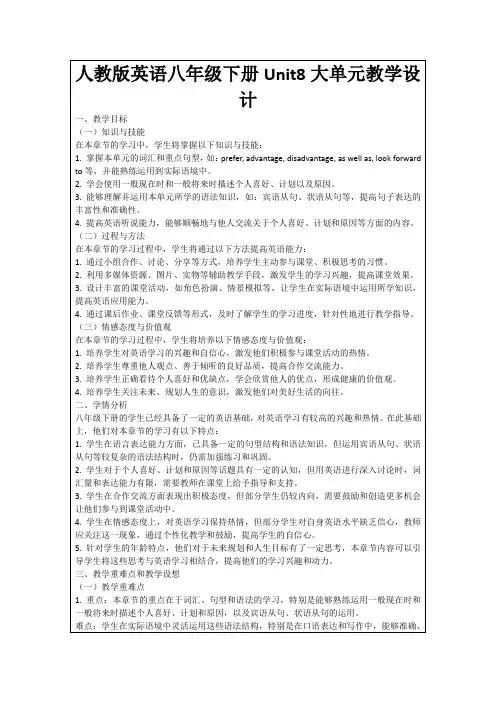
(三)学生小组讨论
1.教学活动:将学生分成小组,让他们围绕一个话题(如:个人喜好、未来计划等)进行讨论。
2.教学要求:小组成员用英语进行交流,尽量运用新学的词汇和语法结构,讨论过程中做好记录。
3.小组展示:各小组选派一名代表进行成果展示,其他小组成员给予评价和反馈。
-设计情境对话,让学生在实际语境中练习句型和语法,提高应用能力。
-通过课后作业和课堂练习,巩固词汇和语法知识,及时发现并解决学生的疑惑。
2.针对听说能力的培养,采用以下设想:
-利用多媒体资源,如英语歌曲、电影片段等,激发学生的学习兴趣,提高听力水平。
-设计各种口语活动,如小组讨论、角色扮演等,让学生在实践中提高口语表达能力。
-鼓励学生参加英语角、英语演讲比赛等活动,增加实际运用英语的机会。
3.针对情感态度和价值观的培养,采用以下设想:
-结合教学内容,设计富有教育意义的活动,如讨论梦想、分享成长故事等,引导学生形成积极的人生观。
-在课堂教学中,关注学生的情感需求,营造轻松愉快的学习氛围,增强学生的自信心。
-课后鼓励学生进行反思,将自己的学习体验和情感态度融入其中,促进个人成长。
4.写作练习:以"My Hobbies and Plans"为题,写一篇不少于80词的英语短文,要求描述自己的个人喜好、优缺点以及未来计划。
5.阅读理解:阅读一篇与本节课话题相关的英语文章,完成文章后的相关问题,提高阅读理解能力。
6.课后反思:总结本节课所学内容,思考自己在英语学习中的优点和不足,并制定相应的改进措施。
人教版英语八年级下册Unit8大单元教学设计
人教版八年级英语下册Unit5大单元教学设计
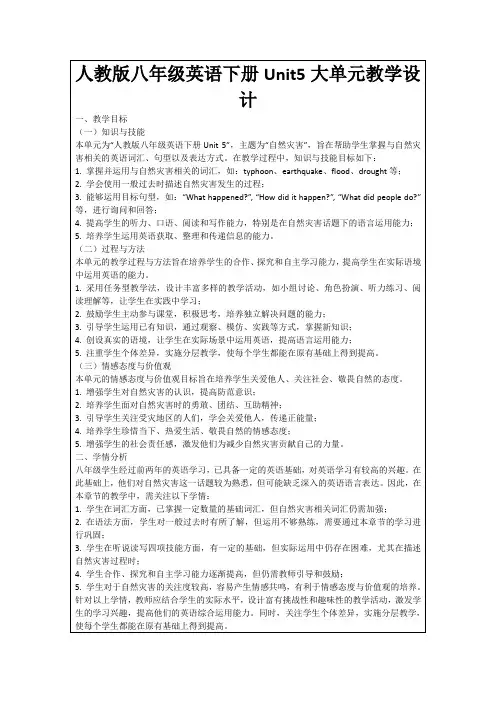
一、教学目标
(一)知识与技能
本单元为“人教版八年级英语下册Unit 5”,主题为“自然灾害”,旨在帮助学生掌握与自然灾害相关的英语词汇、句型以及表达方式。在教学过程中,知识与技能目标如下:
1.掌握并运用与自然灾害相关的词汇,如:typhoon、earthquake、flood、drought等;
5.学生对于自然灾害的关注度较高,容易产生情感共鸣,ห้องสมุดไป่ตู้利于情感态度与价值观的培养。
针对以上学情,教师应结合学生的实际水平,设计富有挑战性和趣味性的教学活动,激发学生的学习兴趣,提高他们的英语综合运用能力。同时,关注学生个体差异,实施分层教学,使每个学生都能在原有基础上得到提高。
三、教学重难点和教学设想
4.创设真实的语境,让学生在实际场景中运用英语,提高语言运用能力;
5.注重学生个体差异,实施分层教学,使每个学生都能在原有基础上得到提高。
(三)情感态度与价值观
本单元的情感态度与价值观目标旨在培养学生关爱他人、关注社会、敬畏自然的态度。
1.增强学生对自然灾害的认识,提高防范意识;
2.培养学生面对自然灾害时的勇敢、团结、互助精神;
5.教学支持:
(1)为教师提供丰富的教学资源,如教材、课件、网络资源等,提高教学质量;
(2)加强教师培训,提高教师在自然灾害话题下的教学能力;
(3)鼓励教师开展课题研究,不断优化教学设计。
四、教学内容与过程
(一)导入新课
1.教师通过展示一组自然灾害的图片,如台风、地震、洪水等,引发学生对自然灾害的思考,激发他们的学习兴趣。
(二)教学设想
1.教学方法:
(1)采用任务型教学法,设计丰富多样的教学活动,如小组讨论、角色扮演、听力练习等,激发学生的学习兴趣;
及分析人教版英语八年级下册Unit3大单元教学设计
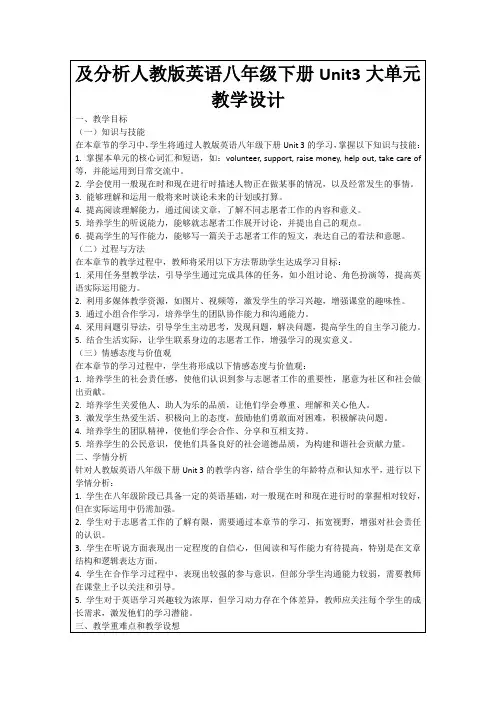
-定期组织展示活动,让学生在实践中展示自己的学习成果,增强自信心。
4.教学延伸:
-鼓励学生参与学校或社区的实际志愿者活动,将所学知识运用到实践中。
-建立学习小组,利用课后时间进行英语角活动,提高学生的语言实际运用能力。
-结合单元主题,开展跨学科活动,如社会调查、研究报告等,拓宽学生的学习视野。
4.口语作业:与家人或朋友进行一次关于志愿者工作的英语对话,尝试使用本节课学到的词汇和时态,记录下对话内容。
5.研究任务:选择一个感兴趣的志愿者组织或活动,通过网络或图书馆资源,了解该组织或活动的基本信息、活动宗旨和参与方式,下节课向同学分享。
作业布置注意事项:
-确保作业难度适中,既能巩固课堂所学,又不会给学生造成过重的负担。
四、教学内容与过程
(一)导入新课
在这一阶段,教师将运用多媒体资源,以生动有趣的方式导入新课。首先,在大屏幕上展示一组志愿者活动的图片,如环保清洁、帮助老人过马路等,让学生们观察并思考这些图片中的共同点。随后,提出问题:“What are they doing? Why do they do these things?”引导学生展开思考。
(二)过程与方法
在本章节的教学过程中,教师将采用以下方法帮助学生达成学习目标:
1.采用任务型教学法,引导学生通过完成具体的任务,如小组讨论、角色扮演等,提高英语实际运用能力。
2.利用多媒体教学资源,如图片、视频等,激发学生的学习兴趣,增强课堂的趣味性。
3.通过小组合作学习,培养学生的团队协作能力和沟通能力。
-通过真实语境的创设,让学生在实践中感受时态的用法,提高口语表达能力。
-引导学生通过预读、细读和总结等步骤,提高阅读理解能力。
人教版八年级下册英语教案unit1
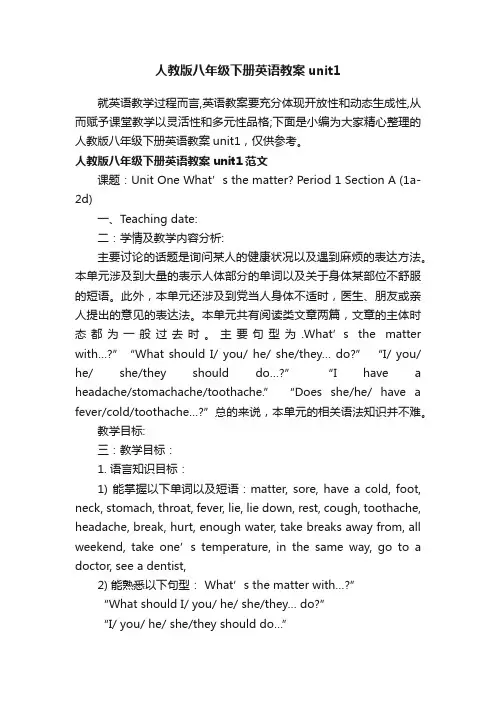
人教版八年级下册英语教案unit1就英语教学过程而言,英语教案要充分体现开放性和动态生成性,从而赋予课堂教学以灵活性和多元性品格;下面是小编为大家精心整理的人教版八年级下册英语教案unit1,仅供参考。
人教版八年级下册英语教案unit1范文课题:Unit One What’s the matter? Period 1 Section A (1a-2d)一、Teaching date:二:学情及教学内容分析:主要讨论的话题是询问某人的健康状况以及遇到麻烦的表达方法。
本单元涉及到大量的表示人体部分的单词以及关于身体某部位不舒服的短语。
此外,本单元还涉及到党当人身体不适时,医生、朋友或亲人提出的意见的表达法。
本单元共有阅读类文章两篇,文章的主体时态都为一般过去时。
主要句型为.What’s the matter with…?”“What should I/ you/ he/ she/they… do?” “I/ you/ he/ she/they should do…?” “I have a headache/stomachache/toothache.” “Does she/he/ have a fever/cold/toothache…?”总的来说,本单元的相关语法知识并不难。
教学目标:三:教学目标:1. 语言知识目标:1) 能掌握以下单词以及短语:matter, sore, have a cold, foot, neck, stomach, throat, fever, lie, lie down, rest, cough, toothache, headache, break, hurt, enough water, take breaks away from, all weekend, take one’s temperature, in the same way, go to a doctor, see a dentist,2) 能熟悉以下句型:What’s the matter with…?”“What should I/ you/ he/ she/they… do?”“I/ you/ he/ she/they should do…”2. 情感态度价值观目标:教会学生关心他人,培养同学间团结、友善的精神。
八年级英语下册(人教版)Unit2单元整体优秀教学案例
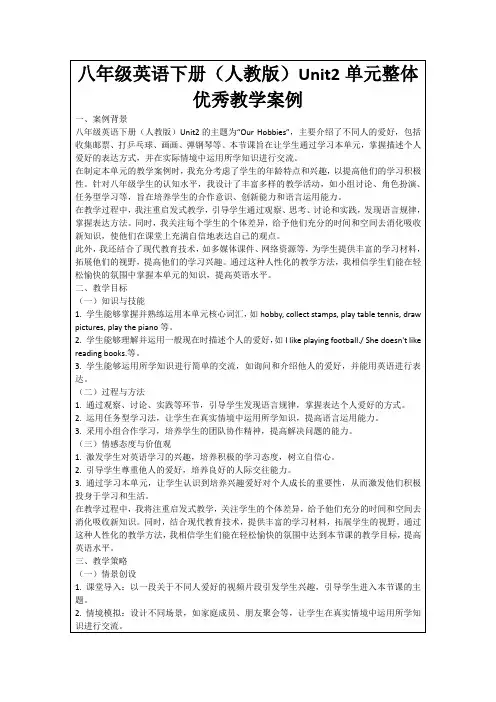
(一)导入新课
1.课堂起始,我将以一个有趣的问题引导学生思考:“同学们,你们有自己的爱好吗?能分享一下吗?”让学生自由发言,谈论自己的兴趣爱好。
2.紧接着,我会展示一段关于不同人爱好的视频片段,如收集邮票、打乒乓球、画画等,引导学生关注本节课的主题。
3.然后,我会向学生介绍本节课的学习目标,让他们明确本节课需要掌握的知识和技能。
二、教学目标
(一)知识与技能
1.学生能够掌握并熟练运用本单元核心词汇,如hobby, collect stamps, play table tennis, draw pictures, play the piano等。
2.学生能够理解并运用一般现在时描述个人的爱好,如I like playing football./ She doesn't like reading books.等。
2.合作完成任务:学生分组完成相关任务,如制作关于爱好的海报、编写对话等。
3.小组互评:学生相互评价,给出建议和意见,共同提高。
(四)反思与评价
1.学生自我反思:让学生回顾本节课的学习过程,总结自己的收获和不足。
2.同伴评价:学生相互评价,给出建议和意见,促进共同进步。
3.教师评价:教师对学生的学习过程和成果进行评价,给予鼓励和指导。
(二)讲授新知
1.通过PPT展示本节课的核心词汇,如hobby, collect stamps, play table tennis等,并引导学生跟读,确保他们正确掌握这些词汇。
2.接着,我会运用一般现在时引导学生描述个人爱好,如“I like playing football.”“She doesn't like reading books.”等,并让学生进行模仿练习。
人教版八年级英语下册Unit1What’sthematter(16课时)教学设计
2.增强学生的健康意识,使其认识到健康的重要性,养成良好的生活习惯。
3.培养学生积极向上的心态,面对困难和挫折时,能够保持乐观,寻求帮助。
4.通过学习英语,拓宽学生的国际视野,使其了解并尊重不同文化背景下的健康观念。
5.鼓励学生参与课堂活动,增强自信心,培养合作精神。
3.加强词汇教学,通过游戏、竞赛等形式,帮助学生记忆和巩固词汇。
4.设计多样化的听力练习,提高学生的听力水平,培养其英语语感。
5.关注学生的情感态度,引导他们正确面对健康问题,培养积极的心态。
三、教学重难点和教学设想
(一)教学重难点
1.词汇和短语:本章节的重点词汇和短语涉及描述健康问题的各个方面,如身体部位、症状等。这些词汇和短语的掌握对于学生能够流畅地表达和交流至关重要。
3.听力训练:利用课外时间,观看英语原声视频,如健康主题的TED演讲或医生与患者的对话,提高听力水平,并记录下新学到的表达方式。
4.口语作业:与同学组成小组,进行角色扮演,录制一段关于健康问题的对话视频,要求每个成员都有发言机会,并在视频中加入适当的身体语言。
5.写作练习:写一篇关于“如何保持健康生活方式”的短文,至少80词,使用本节课学习的词汇和句型,表达个人观点。
3.学生分享:鼓励学生分享自己在生活中遇到的健康问题及解决方法,激发学生兴趣,为新课学习做好铺垫。
(二)讲授新知
1.教学内容:教师针对本节课的重点词汇、短语和句型进行讲解,如:“What’s the matter?” “I have a toothache/too much homework.” “You should/need to…”等。
人教版八年级英语下册Unit3SectionA1a~2d教学设计
(二)教学设想
1.针对一般现在时态的教学,我将采用以下策略:
a.通过生动的情景剧或动画,让学生在具体的语境中感知一般现在时态的使用,增强记忆。
b.设计互动性强的课堂活动,如角色扮演、口头报告等,让学生在练习中巩固时态运用。
c.创造语境,引导学生用一般现在时态描述自己的生活,提高语言实际运用能力。
针对以上学情,教师在教学过程中应关注学生的个体差异,因材施教,激发学生的学习兴趣和积极性,帮助他们克服困难,提高英语综合运用能力。同时,注重培养学生的学习策略,提高自主学习、合作学习和探究学习的能力。
三、教学重难点和教学设想
(一)教学重难点
1.重点:本章节的重点在于学生对一般现在时态的掌握,能够运用该时态描述家庭成员或朋友的日常活动和习惯,以及正确使用频率副词。
5.增进对英语学科的兴趣,激发学习热情,树立长远的学习目标。
二、学情分析
八年级学生经过前两年的英语学习,已经具备了一定的英语基础,对英语学科有了一定的认识和兴趣。在此基础上,他们对本章节内容的掌握情况如下:
1.在语法方面,学生对一般现在时态有初步的了解,但在实际运用中仍存在一定的困难,需要进一步巩固和练习。
5.鼓励学生积极参与课堂活动,培养自主学习、合作学习和探究学习的能力。
(三)情感态度与价值观
1.增强对家庭、朋友之间相互关爱的认识,培养乐于助人的品质。
2.树立正确的价值观,认识到合理安排时间、养成良好习惯的重要性。
3.增强自信心,敢于在真实的语境中运用英语进行交流,克服羞涩心理。
4.培养合作意识,学会倾听、尊重他人,提高人际交往能力。
四、教学内容与过程
(一)导入新课
人教版英语八年级下册Unit10SectionB2a~2d教学设计
3.能够运用阅读策略(如:预测、略读、寻读、精读等)理解阅读材料,提高阅读效率。
4.能够通过小组讨论、发表个人观点,培养口语表达能力。
5.能够通过写作练习,巩固一般过去时态的运用,并提高写作水平。
(二)过程与方法
在本章节的教学过程中,学生将通过以下方法提高英语能力:
2.在语法方面,学生对一般过去时的运用尚不熟练,需要通过本节课的学习,加强练习,提高运用能力。
3.在阅读理解方面,学生的阅读速度和理解能力有待提高。本节课的阅读材料内容丰富,涉及不同主题,有助于培养学生快速获取信息、提炼关键信息的能力。
4.在口语表达方面,学生的表达能力参差不齐,部分学生可能存在紧张、胆怯的情绪。教师应鼓励学生积极参与课堂讨论,提高口语表达能力。
四、教学内容与过程
(一)导入新课
1.教师通过展示一组图片,图片内容包括学生熟悉的日常生活场景,如:play sports, go to the zoo, visit museums等,引导学生回忆过去的生活经历。
2.学生在观察图片的过程中,教师邀请他们用一般过去时描述图片中的活动,如:“I played basketball last weekend.” “We visited the zoo last month.”
二、学情分析
八年级下册的学生已经具备了一定的英语基础,他们对一般现在时、一般过去时等基本时态有了一定的了解和掌握。在此基础上,本章节将针对Unit10 Section B 2a~2d的内容进行学情分析:
1.学生在词汇方面,已掌握了一定数量的词汇,但对于本节课的一些新词汇,如:frighten, exciting等,可能仍感到陌生,需要教师在课堂上进行重点讲解和引导。
人教版八年级英语下册Unit5单元整体教学设计
5.培养学生的写作能力,能够撰写一篇关于自己或朋友日常活动和兴趣爱好的小短文。
(二)过程与方法
1.采用任务型教学法,引导学生通过观察、思考、讨论等方式,发现和归纳语言规律。
2.运用小组合作学习,让学生在互动交流中练习和巩固目标语言,提高口语表达能力。
-鼓励学生积极参与课堂活动,给予充分的肯定和鼓励,帮助他们克服口语表达的恐惧心理。
3.针对阅读教学,采用以下策略:
-设计不同类型的阅读练习,如略读、寻读、精读等,培养学生的阅读技巧。
-引导学生关注文章细节,学会从文中提取关键信息,提高阅读理解能力。
-组织课堂讨论,让学生分享阅读心得,培养他们的思维能力和语言表达能力。
2.小组成员互相交流,分享自己的描述,讨论如何改进表达,提高口语水平。
3.教师巡回指导,给予建议和鼓励,关注学生在讨论中的语言运用情况。
(四)课堂练习
1.教师设计不同类型的练习,如填空、选择、改错等,让学生巩固一般现在时的用法。
2.学生进行角色扮演,模拟真实场景,运用所学语言进行对话。
3.教师提供一篇关于人物描述的短文,要求学生阅读并完成相关的阅读练习,提高阅读理解能力。
-作业量适度,避免给学生造成过重的负担,确保他们有足够的时间休息和参加课外活动。
-鼓励学生自主完成作业,培养他们的自主学习能力和责任感。
5.在下次课堂上,教师将检查学生的作业完成情况,给予评价和反馈,鼓励学生持续进步。同时,针对作业中的共性问题,进行集中讲解,确保学生掌握所学知识。
2.利用多媒体展示不同人物的图片,让学生观察并描述人物的外貌、性格和爱好,如:“He is tall and outgoing. He likes playing basketball.”通过这种方式,复习和巩固描述人物的形容词和动词短语。
- 1、下载文档前请自行甄别文档内容的完整性,平台不提供额外的编辑、内容补充、找答案等附加服务。
- 2、"仅部分预览"的文档,不可在线预览部分如存在完整性等问题,可反馈申请退款(可完整预览的文档不适用该条件!)。
- 3、如文档侵犯您的权益,请联系客服反馈,我们会尽快为您处理(人工客服工作时间:9:00-18:30)。
八年级英语下学期U n i t
教案
This manuscript was revised by the office on December 10, 2020.
课题 Unit 8 Why don’t you get her a scarf Period 7教学目标
Objects
Reading: Why don’t you learn to sing English songs
Objects
To train students’ reading comprehension.
To train students how to use the strategy of reading.
and Value
To be interested in learning English by singing English songs.
教材分析
Key Points
Key vocabulary.
Section 1.
Section 2.
Difficulties
Section 3.
Section 4.
板书设计
Reading: Why don’t you learn to sing English songs
An example of the summary of the reading.
________________________
________________________
________________________
________________________
时序教学操作过程设计(重点写怎么教及学法指导,含课练、作业安排)Step Ⅰ Greet the class as usual and check the homework.
Show the new words on the screen. Ask students to read the words one by one. Correct any mistakes. Then read them to the class and ask students to repeat.
Step 2
Section 1 Before You Read
Pairwork
1a
Ask students How many English songs can you think of
Which are your favorites
Let students work in pairs.
1b
Get students to look at 1b and ask students How can singing English songs help your English Discuss it with your partner and make a list.
Get students to complete it. Students do not look at the reading yet. Instead, they work in pairs and use their background knowledge to try to make a list of how can singing English songs help one’s English abilities. As students complete this task, move around the room and look at their progress.
Once most students finish, ask a few pairs of students to share their answers with the class.
Answers will vary.
Step 3
Find out the new words. ( PPT)
Step 4
True or false ( PPT)
Step 5
Answer the questions ( PPT)
Step 6
Section 2 While You Read
Read the title Why don’t you learn to sing English songs
Get students to predict what they think the article is about, based on the title. Ask the students what English songs they like best.
Play the tape for students and ask students to read the text.
Step 7
Section 3 After You Read
3a
Read the instructions with the students. Ask students to read the article again and complete the task. As they work, walk around the room and check their progress. Check the answers. Get students to explain from where in the story they got their answers.
3b
Ask students Have you ever tried improving your English using any of the ways mentioned in the reading What other ways can you think of to improve your English
Get students to work in pairs. A few minutes later, ask some pairs to say something about the two questions.
3c
Ask students to go through the reading again. Then close their books. Write a summary of the passage using no more than 100 words. Tell students they can start like this: Because China will be the host for the 2008 Olympics,....
When students work, walk around the room and provide help when they need.
After they finish, ask several students to read their summary and help them correct any mistakes.
Step 8
Section 4 Go for It!
First ask students Do you want to be a volunteer of the Olympics in 2008
Ask students to write some ways that they want to be a volunteer of the Olympics in 2008.
Then ask students to give each other some suggestions to achieve this dream.
Let students finish this task.
Step 9 Summary
In this class we’ve learned the reading. And we knew something about singing English songs. We also knew singing English songs is a good way to improve our English.
Step 10 Homework
Review this unit.
Preview the ne xt unit. Next class we’ll start Unit 9.。
